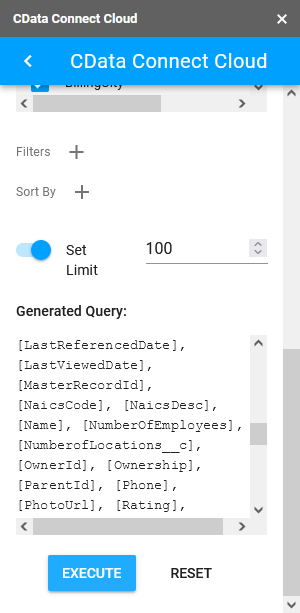Discover how a bimodal integration strategy can address the major data management challenges facing your organization today.
Get the Report →Access Live Salesforce Marketing Data in Google Sheets
Use CData Connect Cloud to gain access to live Salesforce Marketing data from your Google Sheets.
Google Sheets is a web-based spreadsheet program provided by Google. When integrated with CData Connect Cloud, you can effortlessly gain access to Salesforce Marketing data directly within Google Sheets for tasks such as data analysis, collaboration, calculations, and more. This article offers a comprehensive guide on connecting to Salesforce Marketing within your Connect Cloud instance and accessing live Salesforce Marketing data seamlessly within Google Sheets.
CData Connect Cloud offers a seamless cloud-to-cloud interface designed for Salesforce Marketing, enabling effortless access to live Salesforce Marketing data directly within Google Sheets. Use the dedicated Connect Cloud Google Sheets Plug-In to connect with live Salesforce Marketing data. With built-in optimized data processing, CData Connect Cloud efficiently channels all supported query operations, including filters, JOINs, and more, directly to Salesforce Marketing. This leverages server-side processing to promptly retrieve the desired Salesforce Marketing data.
This setup requires a CData Connect Cloud instance and the CData Connect Cloud Add-On for Google Sheets. To get started, sign up a free trial of Connect Cloud and install the free Connect Cloud Google Sheets Add-On.
Configure Salesforce Marketing Connectivity for Google Sheets
Connectivity to Salesforce Marketing from Google Sheets is made possible through CData Connect Cloud. To work with Salesforce Marketing data from Google Sheets, we start by creating and configuring a Salesforce Marketing connection.
- Log into Connect Cloud, click Connections and click Add Connection
![Adding a Connection]()
- Select "Salesforce Marketing" from the Add Connection panel
![Selecting a data source]()
-
Enter the necessary authentication properties to connect to Salesforce Marketing.
Authenticating to the Salesforce Marketing Cloud APIs
Set the User and Password to your login credentials, or to the credentials for a sandbox user if you are connecting to a sandbox account.
Connecting to the Salesforce Marketing Cloud APIs
By default, the data provider connects to production environments. Set UseSandbox to true to use a Salesforce Marketing Cloud sandbox account.
The default Instance is s7 of the Web Services API; however, if you use a different instance, you can set Instance.
![Configuring a connection (Salesforce is shown)]()
- Click Create & Test
- Navigate to the Permissions tab in the Add Salesforce Marketing Connection page and update the User-based permissions.
![Updating permissions]()
With the connection configured, you are ready to connect to Salesforce Marketing data from Google Sheets.
Access Live Salesforce Marketing Data from Google Sheets
The steps below outline connecting to CData Connect Cloud from Google Sheets to access live Salesforce Marketing data.
- Log into Google Sheets, create a new sheet (or open an existing one).
- Click Add-ons and click Get Add-ons (if you have already installed the Add-on, jump to step 5).
- Search for CData Connect Cloud Add-On and install the Add-on.
![Install the Add-On]()
- Authorize the Add-On.
![Authorize the Add-On]()
- Back in Google Sheets, click Add-ons and open the CData Connect Cloud Add-On.
![Opening the Add-On]()
- In the Add-On panel, click Authorize to authenticate with your CData Connect Cloud instance
![Authenticating with CData Connect Cloud]()
- In the CData Connect Cloud panel in Google Sheets, click Import
![CData Connect Cloud panel in Google Sheets]()
- Choose a Connection (e.g. SFMarketingCloud1), Table (e.g. Subscriber, and Columns to import
![Cheesing a Connection, Table, and Columns]()
- Optionally add Filters, Sorting, and a Limit
![Filters, Sorting, Limits]()
- Click Execute to import the data
Live Access to Salesforce Marketing Data from Cloud Applications
New, you have a direct, cloud-to-cloud connection to live Salesforce Marketing data from your Google Sheets workbook. You can add more data to your workbook for calculations, aggregations, collaboration, and more.

Try CData Connect Cloud and get real-time data access to 100+ SaaS, Big Data, and NoSQL sources directly from your cloud applications.

















